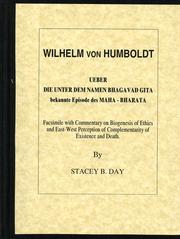Check nearby libraries
Buy this book

Black board cover with yellow parchment style title on front. Back shows classical Hindu Trinity.Illustrations include "Battle Line at Kurekshetra" from a sequence of sculptures in the Sri Aurobindo Ashram, Pondicherry, India.Also a portrait of Wilhelm von Humboldt, and a portrait of the author Professor Stacey B. Day with Professor Ctibor Votrubec of Prague, together in a garden in South Bohemia, discussing Meister Eckhardt and Gottesfreunde. On his excommunication in 1329, Eckhart remarked: "if the ignorant are not taught they will never learn". In a prefatory note the author says" "In fact the Gita, I think, brings to mind "la phrase de Mozart enfant - je cherche les notes qui s'aiment' , and therein is the joy that reverberates within the spiritual inside of the reader. As for its "interpretation", the Gita in its essence very much resembles the mysterious depths and aura of La Gioconde. Find within it what will best bring you to peace".
Check nearby libraries
Buy this book

Subjects
Commentaries, Hinduism, Literature, Sanskrit, BhagavadgītāShowing 1 featured edition. View all 1 editions?
| Edition | Availability |
|---|---|
|
1
Wilhelm von Humboldt: UÌber die unter dem Namen Bhagavad-Gita bekannte Episode des Maha-bharata: facsimile with commentary on biogenesis of ethics and ... of complementarity of existence and death
2001, International Foundation for Biosocial Development an Human Health
Unknown Binding
in English
- Original. Includes glossary of commonly used Sanskrit terms.
0934314470 9780934314473
|
aaaa
Libraries near you:
WorldCat
|
Book Details
First Sentence
"Throughout academic life I sought to express my experiences and reflections from a position that gave balance to both Eastern and Western cultures. This was rarely an agreeable ground to stand on, I found, for confrontation and exclusivity rather than consideration and engagement seemed more often than not the basis of dialogue between the common layers of both cultures. Western life has of course been informed, over the last two thousand years, by Christianity, which though not uniform in its theological history and ideas, has been as much concerned with nation building, (e.g. Holy Roman Empire), as with the rubric of religion and with what may be at change within the human person in nature."
Table of Contents
Edition Notes
Page 194 et seq. How Krishna presents himself in his own varying state - Highest Lord, Deity, Deity Absolute. from this dialog we understand that God "the all-faced one"
faces in every direction, that is, He is omnipresent. (IX.II). The Lord is eternal, invisible (XII.3., VII.24-25) and so forth.
Plotinus -cf/ct teachings in the Aenneads.
Platonic Parmenedes.
Textual German expressions used by Professor Humboldt.
List of suggested Readings.
Classifications
The Physical Object
ID Numbers
Community Reviews (0)
Feedback?| December 19, 2020 | Edited by MARC Bot | import existing book |
| March 7, 2012 | Edited by Mary Murrell | merge authors |
| April 28, 2010 | Edited by Open Library Bot | Linked existing covers to the work. |
| December 11, 2009 | Created by WorkBot | add works page |









